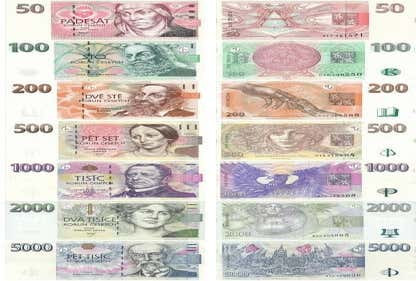When planning your trip to the enchanting city of Prague, understanding the local currency is crucial for a smooth and budget-friendly experience. The official currency of the Czech Republic is the Czech koruna (CZK), often called the Czech crown in English, and locally known as koruna Česká (Kč). While some places, especially in tourist hotspots, might accept Euros, it’s always best to operate in the local currency to avoid unfavorable exchange rates and potential confusion. This guide will equip you with everything you need to know about Czech Money, from banknotes and coins to payment methods and currency exchange tips, ensuring you handle your finances like a seasoned traveler in Prague.
The Czech Koruna comes in a variety of denominations, both in banknotes and coins, making transactions convenient for all types of purchases. Banknotes are available in denominations of Kč 100, Kč 200, Kč 500, Kč 1,000, Kč 2,000, and Kč 5,000. These colorful banknotes are not only practical but also visually appealing, often featuring prominent Czech historical figures. You’ll find coins in denominations of Kč 1, Kč 2, Kč 5, Kč 10, Kč 20, and Kč 50. Familiarizing yourself with both the banknotes and coins will make everyday transactions, from grabbing a coffee to paying for souvenirs, much easier and quicker.
 Close-up of Czech Koruna banknotes and coins, the official currency of Prague and the Czech Republic
Close-up of Czech Koruna banknotes and coins, the official currency of Prague and the Czech Republic
Finding banks and ATMs in Prague, particularly in the city center, is remarkably easy. You’ll encounter ATMs from various international and local banks readily available throughout tourist areas, shopping districts, and even smaller neighborhoods. If you need to visit a bank branch for more complex transactions, keep in mind that typical operating hours are from Monday to Friday, 8 am to 5 pm. Using ATMs is generally a straightforward way to withdraw Czech money, but be mindful of potential withdrawal fees charged by your bank and the ATM operator. It’s always wise to check these fees beforehand to optimize your cash withdrawals.
In Prague, like many modern travel destinations, using bank cards for payments is widely accepted and often recommended for its convenience and favorable exchange rates. Paying with debit or credit cards typically involves an exchange rate with a margin of around 1%, which is often more competitive than rates offered at currency exchange bureaus. Before making a purchase at a local store or enjoying a meal at a traditional Czech restaurant, it’s always a good practice to inquire whether card payments are accepted. While major establishments readily accept cards, smaller shops or local markets might prefer or exclusively accept cash. Being prepared with both payment methods ensures you can handle any transaction scenario in Prague.
When it comes to exchanging currency in Prague, the city offers numerous options, but it’s essential to choose wisely to get the best value for your money. Currency exchange bureaus located in the heart of Prague, especially in areas like Staré Město (Old Town) and Malá Strana (Lesser Town), generally provide the most competitive exchange rates. Conversely, exchanging money at banks might involve a commission fee, typically around 2%, and currency exchange services in hotels or at Václav Havel Airport Prague are usually the least favorable due to less competitive rates and higher fees. When using exchange bureaus, always ask for the exact amount of Czech koruna you will receive for your Euros or US dollars before proceeding with the transaction. Be cautious of signs advertising “0% commission,” as these can be marketing tactics that might hide less favorable exchange rates.
Before your departure for Prague, it’s a smart move to investigate the foreign transaction fees associated with your bank cards. Understanding these charges will give you a clearer picture of the actual cost when using ATMs abroad and making card payments in Czech currency. This proactive step can help you make informed decisions about whether to rely more on card payments or cash during your trip, optimizing your spending and avoiding unexpected banking fees.
For those who prefer to have Czech money in hand upon arrival, exchanging currency before traveling is an option. You can do this through your local bank, although they often have less competitive exchange rates and higher commissions. Alternatively, specialized currency exchange companies might offer better rates and lower fees, but it’s crucial to compare offers and choose reputable providers. Regardless of where you choose to exchange currency, understanding the current exchange rate and associated fees is key to ensuring you get a fair deal on your Czech money before you even set foot in Prague.
In conclusion, managing Czech money in Prague is generally straightforward and traveler-friendly. By understanding the denominations, payment options, and best practices for currency exchange, you can navigate your finances with confidence and focus on enjoying the rich culture and beauty of this captivating city. Whether you choose to primarily use cards or prefer cash, being informed and prepared will contribute significantly to a stress-free and enjoyable Prague experience.